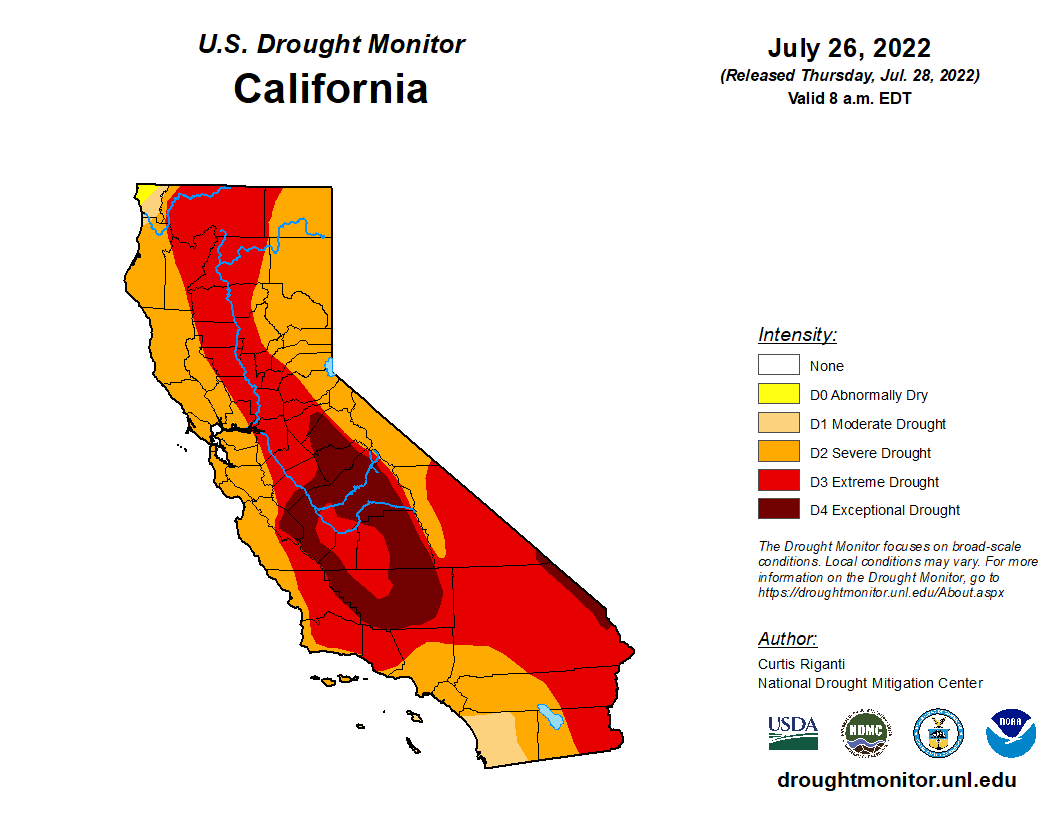Drought Resources
Important Drought Information for Indian Communities
 The California Area Indian Health Service (IHS) Office of Environmental Health and Engineering (OEHE) recognizes how critical access to water is for the protection of public health within the American Indian communities it serves.
The California Area Indian Health Service (IHS) Office of Environmental Health and Engineering (OEHE) recognizes how critical access to water is for the protection of public health within the American Indian communities it serves.
The public health implications of the current drought in California may be significant to California Tribal communtiies given most are located within areas experiencing extreme to exceptional drought as show on the map available from the U.S. Drought Monitor website.
California Area IHS OEHE Division of Sanitation Facilities Construction (DFSC) staff are available to assist Tribal water system operators experiencing any impacts on drinking water due to the drought. For the contact information of the DFSC staff serving your area, visit our About Us page.
Public Health Implications of the Drought
Some of the long-term public health problems caused by drought include:
- Shortages of drinking water
- Poor quality drinking water
- Impacts on sanitation and hygiene
- Impacts on wildfire suppression
- Effects on air quality
- Effects on fish and wildlife
- Increases in the prevalence of diseases such as:
- West Nile Virus
- Valley Fever
- St. Louis Encephalitis
Tribal Community Water Systems
Efforts to reduce water demand and manage water supplies may have tremendous benefits during drought. Primary drought mitigation measures include public health outreach and community education, heightened water conservation awareness, revisions to water rates and schedules and drought contingency plans. Below are a few resources available to assist Tribes with these efforts:
- California Water Board’s Drought Information and Updates Page (CA.gov) Resources include drought financial resources, California drought response information, drought monitoring tools and water conservation tips.
- Association of California Water Agencies Drought Resources Page (ACWA) Resources include the ACWA Drought Toolkit and the Save Our Water Partner Toolkit for use with drought messaging to customers, stakeholders and the media. Also on this page are resources to stay informed about the current drought situation in California.
- Save Our Water (State of California) A website dedicated to promoting wise water use as a daily habit. Offers tips, how-to’s and guides for residents on how to save water.
California IHS: Division of Sanitation Facilities Construction (DSFC)
 To support Tribes in their efforts to mitigate the impacts of the drought, DSFC has completed drought vulnerability assessments for the Tribal water systems in the California Area. These assessments evaluate a Tribal water system’s vulnerability to drought conditions and offers recommendations on efforts to mitigate the impacts of the drought. As the 2021 summer season progresses, DSFC will continue to contact Tribes on a periodic basis to monitor the impact of drought conditions on Tribal water systems.
To support Tribes in their efforts to mitigate the impacts of the drought, DSFC has completed drought vulnerability assessments for the Tribal water systems in the California Area. These assessments evaluate a Tribal water system’s vulnerability to drought conditions and offers recommendations on efforts to mitigate the impacts of the drought. As the 2021 summer season progresses, DSFC will continue to contact Tribes on a periodic basis to monitor the impact of drought conditions on Tribal water systems.
In addition, DSFC staff are available to connect Tribal water system operators to resources available to provide emergency assistance should water supplies issues arise as a result of the drought. For the contact information of the DFSC staff serving your area, visit our About Us page.
Individual/Private Wells on Tribal Lands
Tribal homeowners using a private well are strongly encouraged to conserve water during drought conditions. In addition, before your water well runs out of water, homeowners are encouraged to monitor the performance of their home's well pump as a means to monitor their well's water productivity.
Given that drought conditions can potentially increase the risk of harmful contaminants in well water, ensure that you’ve had your well water tested annually for total coliform bacteria, nitrates, total dissolved solids and pH as recommended by the US EPA. If you reside in an area known for having other contaminants such as arsenic in groundwater, you should test for these contaminants as well.
When testing your well water, use a state certified laboratory. A list of certified labs can be found at the EPA website.
California Area IHS: Division of Environmental Health Services (DEHS)
To support Tribal homeowners and Tribal facility managers with ensuring a safe potable water supply, DEHS staff are available to advise on well water sampling, selecting a testing lab, recommended drinking water tests and interpreting test results. For contact information of the California Area IHS Environmental Health Officer serving your community visit our About Us page.
In addition, DEHS staff are available to provide technical assistance with the identification and mitigation of various public health threats associated with drought. Contact your local California Area IHS Environmental Health Officer for technical assistance regarding drought impacts and:
* Air Quality
* Infectious Diseases such as West Nile Virus and Valley
Fever
* Harmful Algal Blooms in Surface Water
Drought Public Health Resources
Below are some useful resources pertaining to the public health impacts associated with drought.
- Airnow.gov for map of current air quality in your area
- California IHS SFC Drought Contingency Plan Template 2014 (PDF)
- California State/Federal Drought Handbook 2015 (PDF)
- California IHS Drought Factsheet for Well-Owners (PDF)
- CDC West Nile Virus Factsheet
- Factsheet: Warming Temperatures and Changes in Precipitation can increase Vectorborne Disease in California (PDF) (CalEPA 2018)
- Map of Valley Fever Rates in California (PNG) (CDPH, 2018)
- Video: Could Be Valley Fever (YouTube) (CDPH, 2020)
- Valley Fever Prevention Tips (CDPH, 2020)
- Valley Fever Fact Sheet (PDF) (CDPH, 2019)
- Preventing Work-related Valley Fever Resource Page (CDPH)
- Look out for Harmful Algal Blooms Flyer (PDF) (US EPA)
- Harmful Algal Bloom FAQs (California Water Quality Monitoring Council)
- Harmful Algal Blooms: A Physician’s Guide (PDF) (CDPH 2020)
- CDC Physician Reference for Cyanobacterial Blooms (PDF) (CDC
- Creating and Storing an Emergency Water Supply (CDC 2022) (PDF)
- Finding Other Water Sources in an Emergency (CDC 2022) (PDF)
- Make Water Safe During an Emergency
- Personal Hygiene During an Emergency (CDC, 2022) (PDF)
- Preventing Diarrheal Illness After A Disaster (CDC, 2017) (PDF)


 California Area Office
California Area Office